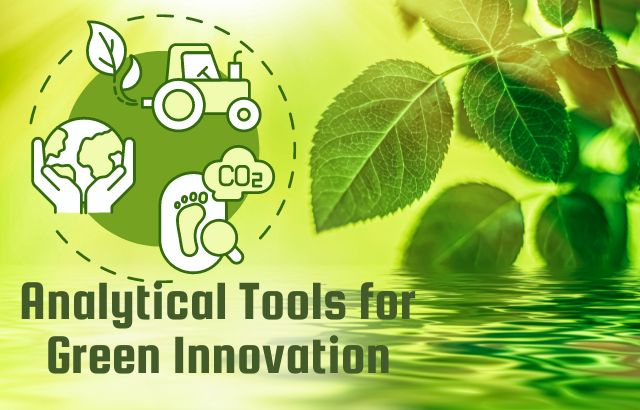Introduction to Green Innovation
Green innovation refers to the development and implementation of products, services, and practices that contribute to environmental sustainability. As a green innovator, one engages in creating solutions that not only address current environmental challenges but also promote long-term ecological balance. This concept encompasses a wide range of activities, from designing energy-efficient technologies and reducing waste to advocating for sustainable business models and policies.
The significance of sustainable practices in today’s world cannot be overstated. With the increasing awareness of climate change, resource depletion, and environmental degradation, there is an urgent need for innovative solutions that mitigate ecological impact. Consumers, businesses, and governments are progressively recognizing the importance of adopting eco-friendly practices, leading to a growing demand for sustainable products and services. This shift towards sustainability is not merely a trend but a fundamental change in how society values and interacts with the environment.
Green innovators play a pivotal role in this transformation by pioneering advancements that align economic growth with environmental stewardship. Their work ensures that progress does not come at the expense of the planet’s health. By focusing on eco-innovation, green innovators contribute to a circular economy, where resources are reused, recycled, and restored, minimizing waste and environmental harm.
Furthermore, authenticity in green innovation is crucial. Genuine commitment to sustainability enhances credibility and fosters trust among stakeholders, including consumers, investors, and partners. Authentic green innovators prioritize transparency, accountability, and continuous improvement, setting themselves apart from those who may engage in greenwashing—misleading claims about environmental benefits. Authenticity ensures that sustainable practices are deeply ingrained in the core values and operations of an organization, leading to meaningful and lasting impact.
As we delve deeper into the world of green innovation, it becomes clear that embracing authenticity and sustainable practices is not only beneficial for the environment but also essential for achieving a resilient and thriving future. The journey of a green innovator is one of dedication, creativity, and responsibility, paving the way towards a more sustainable and equitable world.
The Importance of Authenticity in Green Innovation
In the rapidly evolving landscape of green innovation, authenticity stands as a cornerstone for building trust and credibility among consumers and stakeholders. Genuine efforts in sustainability are not only a moral imperative but also a strategic advantage. Authentic green innovation entails a commitment to transparent and honest practices, which resonate deeply with an increasingly conscientious audience. Consumers today are more informed and discerning, making it essential for green innovators to demonstrate authenticity in their environmental initiatives.
Authenticity in green innovation fosters a robust relationship between businesses and their stakeholders. When companies implement genuine sustainability practices, they signal a commitment to long-term environmental stewardship, which in turn builds trust. This trust is invaluable, as it encourages consumer loyalty and can lead to increased support from investors and partners who prioritize sustainable development. Authenticity also amplifies the positive impact of green innovations, as genuinely sustainable practices tend to be more effective and far-reaching than superficial efforts.
Conversely, the consequences of greenwashing—where companies falsely claim or exaggerate their environmental efforts—can be severe. Greenwashing undermines consumer trust, leading to skepticism and potentially damaging a company’s reputation. Stakeholders, including environmentally conscious investors, are quick to identify and react against insincere sustainability claims. This not only tarnishes the brand but also hampers the broader movement toward genuine environmental progress. Therefore, it is imperative for green innovators to eschew greenwashing and embrace transparency in their operations and communications.
Transparent and authentic practices in green innovation involve clear communication of sustainability goals, progress, and setbacks. By openly sharing their journey, companies can engage their audience more effectively and foster a culture of accountability. Authenticity in green innovation is not just about achieving immediate environmental milestones but also about fostering a long-term vision of sustainability that is credible and inspiring. Ultimately, the authenticity of green innovators can catalyze more profound and lasting changes, driving the collective effort toward a sustainable future.
Key Characteristics of Successful Green Innovators
Successful green innovators possess a unique blend of traits that enable them to drive significant progress in sustainability. Central to their success is creativity, which allows them to envision novel solutions to complex environmental challenges. This creativity is not limited to product development but also extends to innovative business models and strategies that prioritize sustainability. Through their inventive approaches, green innovators are able to transform traditional practices and introduce more eco-friendly alternatives.
Resilience is another core characteristic of green innovators. The path to creating sustainable solutions is often fraught with obstacles, including technological limitations, regulatory hurdles, and market resistance. Successful innovators demonstrate an unwavering commitment to their vision, persisting through setbacks and continuously adapting to overcome challenges. This resilience is essential in navigating the uncertainties and complexities inherent in the quest for environmental stewardship.
An ethical mindset is equally crucial for green innovators. They are driven by a deep sense of responsibility towards the environment and future generations. This ethical foundation guides their decision-making processes, ensuring that their innovations do not compromise ecological integrity. By prioritizing ethical considerations, green innovators earn the trust and support of stakeholders, including consumers, investors, and regulatory bodies, which is vital for the long-term success of their initiatives.
Moreover, a strong commitment to environmental stewardship is a defining attribute of green innovators. They are passionate advocates for sustainable practices and often go beyond their immediate projects to influence broader industry standards and policies. This commitment is evident in their efforts to reduce carbon footprints, conserve natural resources, and promote biodiversity. By leading by example, green innovators inspire others to adopt more sustainable practices.
Real-life examples of renowned green innovators illustrate these characteristics vividly. Elon Musk, for instance, has revolutionized the automotive and energy industries with Tesla and SolarCity, showcasing creativity and resilience. Similarly, Wangari Maathai, through the Green Belt Movement, exemplified an ethical mindset and dedication to environmental stewardship, mobilizing communities to plant millions of trees and combat deforestation.
In conclusion, the key characteristics of successful green innovators—creativity, resilience, ethical mindset, and commitment to environmental stewardship—are instrumental in driving sustainable progress. These traits enable them to overcome challenges, innovate responsibly, and inspire broader societal change towards a more sustainable future.
The Role of Green Innovators in Shaping a Sustainable Future

Green innovators play a pivotal role in shaping a sustainable future by developing and implementing innovative solutions that address pressing environmental challenges. These forward-thinking individuals and organizations are at the forefront of efforts to reduce carbon footprints, mitigate climate change, and foster a greener economy. By leveraging cutting-edge technologies and sustainable practices, green innovators are driving transformative changes across various sectors, from energy and transportation to agriculture and manufacturing.
One of the key contributions of green innovators is the development of renewable energy sources, such as solar, wind, and hydroelectric power. These clean energy solutions are critical in reducing reliance on fossil fuels, thereby decreasing greenhouse gas emissions and combating global warming. Additionally, green innovators are pioneering advancements in energy storage and grid management, ensuring that renewable energy can be efficiently harnessed and utilized even when natural conditions fluctuate.
In the transportation sector, green innovation has led to the creation of electric vehicles (EVs) and sustainable public transit systems. These innovations not only reduce air pollution but also contribute to energy efficiency and lower operating costs. Furthermore, green innovators are exploring alternative fuels, such as hydrogen and biofuels, which have the potential to further decarbonize transportation and reduce our environmental impact.
Agriculture is another area where green innovators are making significant strides. Through the development of sustainable farming practices, such as precision agriculture and organic farming, they are helping to conserve natural resources, enhance soil health, and reduce the use of harmful chemicals. These practices not only benefit the environment but also improve food security and support the livelihoods of farmers.
The broader societal benefits of green innovation are numerous. By fostering a greener economy, green innovators contribute to job creation and economic growth. They also promote environmental stewardship and social responsibility, encouraging businesses and individuals to adopt sustainable practices. Ultimately, the work of green innovators is essential in building a resilient, sustainable future for all.
Steps to Becoming a Green Innovator

Embarking on the journey to becoming a green innovator requires a strategic approach, dedication, and a continuous learning mindset. The first step is to acquire a strong educational foundation in fields related to environmental science, sustainable development, or green technologies. Many universities and online platforms offer specialized courses that can provide you with the necessary knowledge to understand the complexities of sustainability and innovation.
Skill development is equally important. Practical skills in project management, data analysis, and technological proficiency are essential for implementing green solutions effectively. Participating in workshops, internships, and hands-on projects can help you gain these skills and apply theoretical knowledge in real-world scenarios.
Networking plays a crucial role in your journey as a green innovator. Building connections with like-minded professionals, mentors, and organizations can open doors to new opportunities, collaborations, and resources. Attend industry conferences, join sustainability forums, and engage in online communities to expand your network and stay informed about the latest trends and advancements in green innovation.
Staying informed about the latest sustainability trends is vital. The field of green innovation is dynamic, with constant developments in technology, policy, and best practices. Subscribe to industry publications, follow thought leaders on social media, and participate in webinars and workshops to ensure you are up-to-date with current knowledge and practices.
Overcoming common obstacles is a part of the journey. Financial constraints, technological challenges, and regulatory hurdles can pose significant barriers. Developing a resilient mindset and leveraging available resources, such as grants, crowdfunding, and incubators, can help you navigate these challenges effectively. Additionally, maintaining motivation is crucial. Setting clear, achievable goals and celebrating small victories can keep you focused and driven.
By following these steps, aspiring green innovators can effectively contribute to a sustainable future, driving forward the mission of creating a better, greener world for generations to come.
Case Studies of Successful Green Innovations

Exploring case studies of successful green innovations provides a deep understanding of how pioneering efforts in sustainability can lead to significant environmental impacts. These real-world examples demonstrate the potential of green innovators to bring about transformative changes.
One compelling case study is the development of the Tesla Model S. Tesla’s electric vehicle revolutionized the automotive industry by offering a high-performance, zero-emission alternative to traditional gasoline-powered cars. Despite initial skepticism and substantial development costs, Tesla employed advanced battery technology and rigorous testing to overcome these challenges. The result was a vehicle that not only reduced carbon emissions but also gained widespread consumer acceptance, pushing other automakers to accelerate their electric vehicle programs.
Another notable example is the Eden Project in Cornwall, UK. This educational charity transformed a former clay pit into a thriving ecological park that houses the world’s largest indoor rainforest. The Eden Project employs innovative green building techniques, such as biomes constructed with sustainable materials and renewable energy sources. By addressing both environmental and social challenges, the Eden Project has become a global model for sustainable development, attracting millions of visitors and fostering environmental awareness.
The success of Interface, a global leader in modular flooring, underscores the impact of sustainable manufacturing practices. Under the leadership of Ray Anderson, Interface embarked on a mission to eliminate its environmental footprint. Through initiatives like recycling old carpets, using bio-based materials, and reducing waste, Interface successfully cut its greenhouse gas emissions by over 90%. This commitment to sustainability not only improved the company’s environmental impact but also enhanced its market competitiveness and customer loyalty.
These case studies illustrate the diverse strategies and innovative approaches that can drive sustainability forward. Green innovators like Tesla, the Eden Project, and Interface have demonstrated that with vision, commitment, and ingenuity, significant environmental benefits can be achieved. Their successes serve as powerful examples and sources of inspiration for aspiring green innovators worldwide.
The Future of Green Innovation

As the world grapples with the pressing challenges of climate change and environmental degradation, the future of green innovation holds unprecedented significance. Emerging trends in green technology are pivotal in shaping a sustainable future. One of the most promising areas is the development of renewable energy sources. Innovations in solar, wind, and hydroelectric power are not only reducing our reliance on fossil fuels but also driving down costs, making clean energy more accessible globally.
Another critical area is the advancement of energy storage solutions. With the increased adoption of renewable energy, the ability to store and manage energy efficiently is paramount. Breakthroughs in battery technology, such as solid-state batteries and advanced grid storage systems, are paving the way for more reliable and scalable energy solutions. These advancements are essential for ensuring a consistent energy supply, even when renewable sources are intermittent.
In addition to energy, green innovators are making strides in sustainable agriculture and food systems. Precision farming, vertical farming, and regenerative agriculture practices are transforming how we produce food, reducing the environmental impact and enhancing food security. These technologies not only minimize resource use but also promote biodiversity and soil health, ensuring long-term agricultural sustainability.
The role of policy and investment cannot be overstated in advancing green innovation. Governments worldwide are recognizing the urgency of climate action and are implementing policies to support sustainable practices. Incentives for renewable energy projects, carbon pricing mechanisms, and stringent environmental regulations are creating a favorable environment for green innovators. Moreover, increased investment from both public and private sectors is driving research and development, accelerating the deployment of green technologies.
Collaboration is another cornerstone of future green innovation. Cross-sector partnerships between governments, businesses, academia, and non-profit organizations are essential for fostering innovation. These collaborations facilitate the sharing of knowledge, resources, and expertise, leading to more comprehensive and impactful solutions to environmental challenges.
In summary, the future of green innovation is bright, with emerging technologies, supportive policies, and collaborative efforts playing critical roles. Green innovators are at the forefront of this movement, driving transformative changes that promise a sustainable and resilient future for all.
Conclusion: Embracing Authenticity for Sustainable Success

As we navigate the complexities of our modern world, the role of green innovators becomes increasingly crucial. The journey towards sustainability is not just about adopting eco-friendly practices; it’s about fostering a genuine commitment to making a positive impact on our environment. Authenticity in green innovation means aligning your values with your actions, ensuring that your efforts are sincere and impactful.
Throughout this blog post, we have delved into various aspects of green innovation, from understanding its importance to exploring practical steps for becoming a green innovator. We have highlighted how integrating sustainability into your business model or personal life can lead to both environmental and economic benefits. The emphasis has been on the necessity of a holistic approach that combines technological advancements with ethical considerations.
In embracing authenticity, green innovators are not just ticking boxes; they are setting new standards and leading by example. Authentic green innovation requires transparency, accountability, and a relentless pursuit of improvement. It involves not only adopting sustainable practices but also advocating for systemic changes that support a greener future. By doing so, green innovators contribute to a culture of sustainability that can inspire others and create lasting change.
We urge you to take the first step towards becoming a green innovator. Evaluate your current practices, identify areas for improvement, and seek out opportunities to make a difference. Whether you are an individual, a business owner, or part of a larger organization, your role in this movement is invaluable. Embrace the challenge with authenticity and passion, knowing that your efforts are contributing to a more sustainable world.
Let us all commit to being genuine in our pursuit of sustainability. By embracing authenticity, we can drive meaningful change and ensure a healthier planet for future generations. Together, we can innovate for a sustainable future and create a legacy of positive impact.












